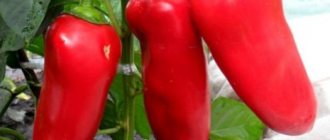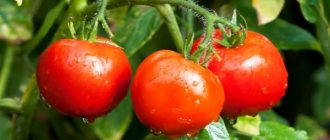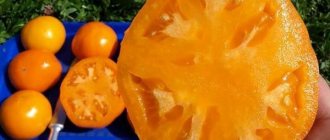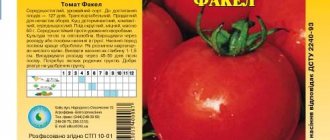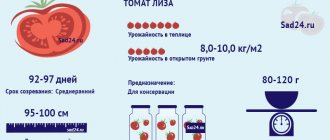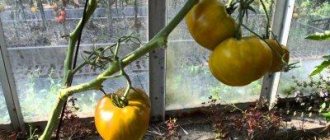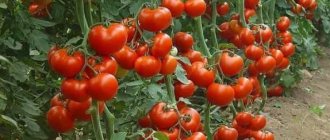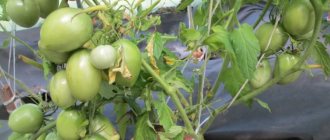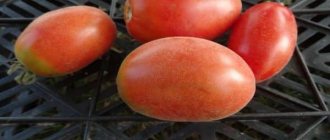How to grow seedlings
Seeds for seedlings are sown 65-70 days before planting in the ground. The final sowing dates are determined by the climatic features of the region.
Seed preparation
Proper seed preparation is important for healthy seedling growth. Since this is not a hybrid, you can collect the seed yourself. Preparation consists of selecting high-quality seeds, disinfecting and improving germination.
First, the seeds are determined for internal filling by immersing them in a saline solution for 10 minutes. The solution is prepared from 1 teaspoon of salt and 1 glass of water. Empty grains will float to the surface. Disinfection consists of treatment with a solution of potassium permanganate. For 20 minutes, the seeds are immersed in a pink solution to disinfect the grains. After the procedure, they are thoroughly washed and dried.
To improve germination, seed material is left in a growth stimulator for 10 hours. A special preparation “Zircon” or melt water is used as a stimulant.
The swollen seeds are ready for sowing.
Container and soil
The soil is prepared from garden soil and humus in equal proportions. Washed river sand is added as a leavening agent. All components are thoroughly mixed and steamed in the oven at a temperature of 60 ° C for 10 minutes or poured with a hot solution of dark potassium permanganate.
The disinfected soil is laid out in planting containers, having previously made drainage holes at the bottom of each of them. In the absence of drainage holes, the accumulation of excess moisture can destroy the root system.
Plant in a common wooden box or separate paper honeycombs, plastic and peat cups. Before planting, any planting container is treated with a manganese solution.
Sowing
Seed material is sown in grooves 1 cm deep at a distance of 2 cm from each other. Sprinkle peat on top, lightly compact, water with warm, settled water using a spray bottle and cover with film. The containers are left in a warm room at a temperature of 24 ° C until the first shoots appear.
Seedling care
As soon as the first shoots appear, the film is removed and the containers are moved to the windowsill. Seedlings need sufficient light, otherwise the seedlings will begin to stretch and weaken. Daylight hours should be at least 13 hours. If there is a lack of natural light, add fluorescent lamps. Additional lighting should be taken care of in advance, especially in regions with short daylight hours.
Water the seedlings with moderately warm, settled water using a tablespoon. Over-wetting the soil increases the risk of the dangerous fungal disease blackleg. The black leg can ruin all plantings in the shortest possible time.
The seedlings are picked after the appearance of 2 true leaves, planted in separate containers. When picking, only strong and healthy plants are left for further development.
If the bushes do not grow very well, they are fed with liquid fertilizer for tomato seedlings. Fertilizing is combined with regular watering.
After watering, the soil is loosened, ensuring air permeability of the soil.
2 weeks before transplanting into the ground, the seedlings are hardened off by taking them outside during the daytime at a temperature of 17 °C. Initially, the seedlings are left in the open air for 1 hour, gradually this time interval is increased to 12 hours.
Landing
Seeds are sown from the second decade of March, using a fertile, loose substrate (the purpose of the soil mixture is “For tomatoes and peppers”).
Seeds are soaked in potassium permanganate (for disinfection), stimulants (to activate germination - Agate, Zircon).
Conditions for seedlings to be strong:
- illumination with phytolamps for up to 12 hours and placement on shelves, window sills, and racks well illuminated by sunlight;
- irrigation through a sprayer or spray bottle;
- fertilizing with complex formulations (2 times per season).
Large fleshy tomatoes for open ground
Tomatoes are grown in open ground in two ways: using seedlings or directly sowing seeds into the ground. The seedling method is more often used, because it is a rather capricious crop that loves warmth. Strong winds and excessive soil moisture can be detrimental to it. Despite the laboriousness of planting tomatoes through seedlings, it is a more reliable method.
Traditional varieties include large, fleshy tomatoes that are very popular among gardeners. After all, they are distinguished by their aroma, and the sugar pulp simply melts in the mouth. Ideal for summer salads, and fresh with salt it’s a pleasure. They can also be pickled by cutting them into pieces. The downside is that they cannot be stored fresh for a long time. Some of the most famous large varieties of tomatoes are:
- Pink honey It has large fruits weighing about 500 grams. It belongs to varieties of medium harvest maturity and is not particularly resistant to diseases. Suitable for fresh salads and for processing into juices;
- Bull's heart. This is a tomato variety loved by many summer residents. The fruits are juicy, very aromatic, and the pulp is fleshy and sugary. The bushes of the plant are tall, the average weight of tomatoes is 300 grams. It has high yields, but is not resistant to diseases. Feeding with fertilizers is required for the ripening and growth of tomatoes;
- Mikado. Early ripening variety, ripening period 90 days. It has very tall bushes up to 2.5 meters long. The fruits can be different in color, round in shape. The fruits are large with dense pulp. They tolerate transportation well and can be stored for a long time. Not very high yield. From one bush 6-8 tomatoes.;
- Handsome. Has tall bushes. They require garters and periodic feeding. The fruits are pink, round, slightly flattened. The average weight of one tomato is 300 grams. The pulp is moderate - juicy, fleshy, with a slight sourness. The variety is cold-resistant, also resistant to winds and drought.
- Raspberry fleshy. This is an early variety. The bush is low-growing and powerful. The variety is characterized by high productivity; up to 6 kg of crop can be harvested from one bush. Has a long fruiting period. The fruits are bright pink, round in shape, weighing about 300-400 g. Universal purpose. The pulp is fleshy, dense, very juicy. The skin is thin and does not crack. It does not require maintenance and is resistant to temperature changes.
To obtain large, ripe tomatoes, you need to consider the following recommendations when growing this crop.
When choosing a place to grow tomatoes, give preference to the south side; the soil should be level and not suffer from excess moisture.
It is not recommended to grow tomatoes in places where potatoes, eggplants, and peppers grew. It is better to choose land after peas, beans, or greens. Before sowing, dig up the soil well and water it with fertilizers and minerals. The beds should be prepared a week before planting seedlings in the ground.
Weed your tomatoes weekly and loosen the soil. Prepare supports for tall bushes of plants in advance; the height of the support should be at least 90 cm. The amount of harvest depends not only on quality care, but also on timely watering of the plants. Do not allow the soil to dry out or crack. And at the same time, overwatering of plants should be avoided, as this can cause various diseases, including fungus.
Tomatoes Fleshy sugary: variety description
| Variety name | Fleshy sugary |
| general description | Mid-season indeterminate variety |
| Originator | Russia |
| Ripening period | 95-105 days |
| Form | Round, slightly elongated |
| Color | Pink |
| Average weight of tomatoes | 250-500 grams |
| Application | Universal |
| Productivity of the variety | 10-12 kg per sq.m. |
| Features of cultivation | The variety responds well to fertilizing containing phosphorus and potassium |
| Disease resistance | Prevention of Phomasis is needed |
This is a tall tomato variety, its height exceeds the standard size of ordinary plants. The bush is of indeterminate type and belongs to standard plants. From planting seedlings to the ripening of the first fruits, 95-105 days pass, that is, it is mid-early. Recommended for growing both in greenhouse shelters and in open ground.
Ripe fruits have a bright pink color, they are round in shape, slightly elongated. The tomatoes themselves are not small, their weight is 250-280 g . Especially large tomatoes are harvested at the first fruiting; their weight can reach 400-500 grams. The number of chambers is 6-7, the dry matter content is approximately 5%. The fruits have a pleasant taste and bright aroma.
The “Fleshy Sugary” tomato was obtained in Russia by our specialists and received state registration as a variety recommended for planting in greenhouses and open ground in 2006. Thanks to its varietal qualities, it has gained popularity among gardeners and farmers. In the southern regions, regardless of where this tomato is grown in greenhouses or in open ground, it gives very good results. In the regions of central Russia and more northern regions, it can also be grown, but the yield may drop significantly.
You can compare the weight of the fruits of this variety with others in the table below:
| Variety name | Fruit weight |
| Fleshy sugary | 250-500 grams |
| Big Mama | 200-400 grams |
| Banana legs | 60-110 grams |
| Petrusha the gardener | 180-200 grams |
| Honey saved | 200-600 grams |
| Beauty King | 280-320 grams |
| Pudovik | 700-800 grams |
| Persimmon | 350-400 grams |
| Nikola | 80-200 grams |
| Right size | 300-800 |
Read more about diseases of tomatoes in greenhouses in the articles on our website, as well as about methods and measures to combat them. You will also be able to get acquainted with information about high-yielding and disease-resistant varieties, about tomatoes that are not at all susceptible to late blight.
Growing rules
Seeds of the Brown Sugar variety can be purchased at a specialty store or collected yourself. If you collect the seeds yourself, you need to take into account that the yield will be much higher, the seedlings will have excellent resistance to diseases and pests. To get a good harvest, you need not only to properly care for vegetables after planting in the ground, but also to follow the recommendations for growing seed.
Planting seedlings
Sowing of seeds begins at the end of March or at the beginning of April. The soil used for seedlings must be light and nutritious. The best option is to mix turf, peat, and sand in equal proportions.
The planting depth is 2 cm; after planting is completed, it is necessary to water the soil. As soon as 2 leaves appear on the bush, they begin to transplant into separate containers, for this they use peat pots, and pick.
Advice! To make seedlings appear faster, cover the container with future seedlings with film.
Transfer
You can transplant seedlings into open ground or a greenhouse in May or early June, depending on the climatic conditions in a particular region. Before planting tomatoes, peat and humus are poured into the bottom of the holes; some people add ash, which makes the soil more nutritious. For 1 sq. m you can plant no more than 3 tomato bushes.
Important! It is recommended to install supports immediately so that you can tie up bushes in the future.
Aftercare
Like any other variety, the Brown Sugar tomato needs proper care and attention. When the height of the bush reaches 50 cm, it is necessary to tie it up, which will prevent damage to the bush.
Vegetables must be watered once every 3 days, avoiding crusting of the soil. The watering depth should reach 30 cm; once a week it is worth loosening the soil to remove weeds.
During the season, fertilizing is carried out at least 4 times, which allows stimulating the growth of the bush and restoring the nutrients that the tomato has already taken for growth.
Description and characteristics of the variety
Red fleshy belongs to the category of salad species. Designed for cultivation in covered beds (film and glass greenhouses, with or without heating).
The variety is mid-season. The first harvest ripens 111–116 days after germination.
Variety characteristics:
- semi-determinant growth;
- the height of the shoots does not exceed 1.5 m;
- large fruit;
- average dates for the onset of fruiting.
Tomatoes contain solid granular and sugary meat in their pulp. The taste is dominated by sweetness. The fruits are used in various culinary salads, used for sauces and ketchups with a rich consistency.
Description of tomatoes:
- average weight - 270–300 g;
- bright scarlet color;
- the skin is glossy, durable, does not crack;
- the flesh is fleshy, tender;
- taste - with dominance of sweet notes against the background of sourness;
- shape - flattened.
The variety bears fruit stably and for a long time (until autumn frosts). Tomatoes are marketable and transport well. They are stored for up to 3–4 weeks.
Features of care
Caring for tomatoes of the Fleshy Sugary variety is simple. Plants of this variety need protection from fungal diseases and pests, so loosening the soil and removing weeds are mandatory care processes. When weeding, garden tools should be deepened no more than 4 cm.
If your region receives moderate precipitation, it is enough to water the tomatoes once a week. In hot climates, the frequency of watering is increased to 2 times a week.
Fertilizer application
Fertilizing Fleshy sugary tomatoes is carried out at intervals of 15 days:
- The first fertilizer is applied 10-15 days after planting the seedlings in the ground. Use ammonium nitrate or urea (100 g per 10 liters of water);
- during the second feeding, superphosphate is used (200 g per 6 liters of water);
- for the third, take a solution of potassium sulfate.
Tying and shaping the bush
The crop does not require the formation of bushes. It is enough to trim the lower stepsons on the plant and remove the brushes from which the harvest has already been harvested.
Tomatoes: advantages and disadvantages
The “Fleshy Sugary” variety has a number of advantages, namely:
- Good yield;
- Possibility of cultivation both in greenhouse conditions and in open ground;
- Immunity to most diseases;
- Excellent taste characteristics;
- Good keeping quality;
- Ability to transport.
The disadvantages of the variety include low yield when grown in northern regions, since it is more recommended for southern regions.
REFERENCE: A feature of tomatoes is their excellent resistance to moisture deficiency and temperature changes.
Growing
The fleshy-sugar tomato is quite unpretentious to grow. The plant withstands direct sunlight and, conversely, lack of light, drought and abundant watering. However, for full fruiting, the crop urgently needs warmth. The amount of harvest that can be harvested depends on proper cultivation. Most of the properties of the future bush are established during the growing of seedlings. Correct and timely planting, adequate fertilizing and suitable climatic conditions are the key to a good harvest.
Growing seedlings
To get a healthy plant, you should first take care of the seedlings. Growing Fleshy-Sugar tomato seedlings is not a troublesome task. Experienced gardeners claim that this variety has good germination. Seeds of ripened tomatoes can be used for replanting next year, but breeders recommend renewing them at least once every three years, otherwise the fruits will become smaller and lose some of their sweetness.
Landing rules
Sowing of seeds should be planned 40 - 45 days before moving into the soil. This means that the most favorable time is mid-March. Since the variety is not frost-resistant, it is advisable to focus on your own region: in the south you can start sowing seeds a little earlier, in the north - later.
For seedlings, it is recommended to use large, shallow boxes. Soil should be placed in them: a mixture of sand, peat, black soil and compost, and grooves should be formed. Before planting in the soil, seeds must be kept in water or a solution that stimulates plant growth for several hours.
Once removed from the liquid, the seeds can be immediately placed in the soil, then sprinkled with a centimeter layer of soil, sprayed with a spray bottle and covered with cling film. Future seedlings should be placed in a warm place. Irrigation is recommended to be carried out daily, at approximately the same time.
After the third leaf appears, the plants should be planted in small individual containers. 2 - 3 weeks before planting in open or closed ground, future tomatoes should begin to be hardened - taken out to the balcony or left in an open window for 10 - 15 minutes.
Already on the 5th – 7th day of cultivation you can see the first shoots. The time should be chosen so that at the beginning of July the plant is ready for planting.
Watering and fertilizing
As mentioned above, the Fleshy-Sugar tomato does not need frequent or abundant watering. A day before planting plants in a greenhouse or beds, they should be fed with mineral fertilizers. In the future, it will be possible to use fertilizing (potassium, phosphate and phosphorus) no more than once a week.
At average temperatures of +27 - 29 °C, you can water the bushes 2 - 3 times a week. When the air warms up above 30 °C, the number of irrigations can be increased to 5 - 6.
Pinching and tying
When cultivating Fleshy-Sugary tomatoes, the first two stepsons will have to be removed: they are non-fruit-bearing. In the future, such branches will take away useful substances from the main plant, reducing the yield.
The bushes of this variety are quite tall and spreading, so they can be significantly deformed when fruit is poured. A garter is necessary immediately after planting in the ground. At the initial stage, it is enough to tie the plant to small pegs. Over time, they will have to be replaced with higher and stronger supports.
Formation
The plant does not require formation. After the appearance of the first two non-viable shoots, the Fleshy-Sugar tomato no longer produces stepsons.
Protection from diseases and pests
This variety is susceptible to fungus and pests. After planting in the soil, you need to take care of mulching - sprinkle the ground with straw or wood shavings. Such troubles as phomosis and late blight can be dealt with by the drugs Hom, Consento and Tattu. Against the invasion of insects - slugs, mole crickets and moths - you can use the Gnome product.
Characteristics and description
This variety is very interesting especially for those who want to get early production and enjoy delicious tomatoes almost at the beginning of summer.
Description of the bush:
- early ripening, determinate: it limits its growth itself, does not need pinching of the top;
- standard: compact bush, powerful, strong stem;
- from emergence to the beginning of ripening – 90-112 days;
- low bush: 40-50 cm3;
- it forms few stepsons and late, so there is almost no need to take stepsons;
- but it is necessary to tie it up: despite the low growth, the variety produces large fruits, they can bend the bush to the ground;
- the yield is quite high - about six kg of ripe tomatoes can be harvested from one bush (subject to the rules of agricultural technology for this variety);
- moderate foliage;
- fruiting is long;
- large-fruited (350-450 g).
Since the Raspberry fleshy tomato is not a hybrid, you can later prepare its seeds for yourself and plant as many as you want.
Fruit
Raspberry fleshy tomatoes are endowed with outstanding qualities, thanks to which gardeners enjoy growing them every season:
- pink-raspberry tomatoes;
- shape - flat-round, slightly ribbed;
- weight: 300-450 g;
- the skin is smooth, thin, but dense;
- reliable resistance to cracking, which ensures excellent transportability;
- multi-chamber;
- the pulp is thickly fleshy, dense, aromatic, juicy;
- high quality taste, sweet;
- a large amount of sugars, beta-carotene, dry matter.
Utility
The increased content of vitamins and minerals, beta-carotene and other beneficial substances help improve health in late spring and early summer, when the body is still weakened after winter.
Purpose
Universal purpose, salad. Tomato is very tasty fresh, “from the bush”, in salads and vegetable slices. Also, fleshy raspberry is excellent for technical processing: juices, pastes, lecho, purees, sauces, adjikas, which are given a wonderful color and rich aroma. The fruits of this variety are excellently used in stewing, baking, frying with other products, and as a result of technical processing and cooking, these tomatoes do not lose their beneficial qualities and substances.
It is poorly suited for canning - large fruits hardly fit into the neck and fit into the jar.
Hospitable Siberian
The Khlebosolny tomato was developed by Novosibirsk entrepreneur Nikolai Dederko
The Khlebosolny tomato appeared in the difficult climate of Siberia. It was bred by Novosibirsk entrepreneur and breeder Nikolai Dederko. The variety was bred at the beginning of the new century and in 2004 was presented to the State Commission for Testing and Protection of Breeding Achievements for variety testing, which lasted two years. In 2006, Khlebosolny was included by the Federal State Budgetary Institution State Varietal Commission in the State Register as a tomato suitable for cultivation in all climatic zones of the country. In November of the same year, the variety was patented. The patent holder is Nikolay Vladimirovich Dederko.
Sugary (sweet) large-fruited tomatoes
There is a wide variety of tomatoes. A gardener can choose and plant a variety that suits his taste and purpose. We are accustomed to the sweet and sour taste of tomatoes. Depending on the variety, more sourness or sweetness may predominate. Sweet tomatoes with sugary pulp are very popular. These tomato varieties are distinguished by their large size. The weight of one tomato can reach 800-900 grams.
Fruits with a sweet, sugary taste make very tasty tomato juice. They also like to ferment them whole in barrels.
The following factors influence the sugar content of tomatoes:
variety of tomato; while planting plants. This is necessary so that the plant acquires the correct shape and has enough strength to saturate the fruits with sugars; conditions for fruit ripening. Gardeners must fertilize the bushes on time, especially minerals such as boron affect the sugar level in tomatoes
Watering should be done in moderation; it is important not to dry out the soil. While treating the bushes from pests, so that the plant does not waste energy on it; weather
Tomatoes are a southern green crop native to America. A sunny and warm summer period is important for her. Then the fruits will be sweeter. tomatoes grown in open ground will have a higher sugar content than those grown in greenhouse conditions; degree of maturity. The fruit must ripen on the bush, not at home. Then it will be sweeter.
When choosing seeds, you should take into account the growing region and the characteristics of the climate zone
Also pay attention to the taste characteristics of the variety. Let's look at sweet large-fruited tomato varieties:
- The Tsar Bell. An unpretentious, mid-season tomato variety. It has large and selected fruits, weighing up to 900 grams, subject to good and timely feeding. The tomatoes are bright crimson in color and resemble a heart in shape. Refers to salad species. The yield is average; they can ripen when picked at home. They tolerate transportation conditions well and are stored fresh for a long time.
- Watermelon. In the southern zone it is grown in open soil, and in the middle zone - in a greenhouse. The variety is very productive; if comfortable conditions are met, you can harvest 5-6 kg of tomatoes from each bush of the plant. The fruits are deep red in color and flat-round in shape. It is consumed fresh and is also widely used for making juices and various sauces. The pulp is fleshy, sugary, there are few seeds inside. When ripe, the skin may crack. The first harvest is larger than subsequent ones. Long fruiting period.
- Crimson giant. This is just a godsend for connoisseurs of early harvest. The first harvest can be harvested within 90-95 days after sowing. It is simple and easy to care for. The bush is low 70-80 cm, quite powerful. The fruits are very large, 500-600 grams, round. The pulp is very juicy and sweet, with a slightly perceptible sourness. The skin is thin, but at the same time dense. Therefore, they are universal in use. The variety is resistant to major types of diseases.
- Monomakh's hat. This variety has been known for more than 15 years. It was developed by agronomists for regions with unstable weather conditions. The bushes are distinguished by their compactness, up to 150 cm, with medium-sized leaves, which allows the fruits to be well illuminated by sunlight. Refers to the average period of fruit ripening. Removal of stepsons is required so that the fruits are larger. Tomatoes are pink, the weight of 1 tomato can reach 800 grams. They taste like sugar with a bright aroma. Due to the large fruits, this variety definitely needs a garter. Drought resistant.
Buy seeds from trusted stores; the packaging must be undamaged. The text should be clearly printed and not blurred. Use knowledge and tricks to get more yield. For example, when watering, add a glass of ash and a teaspoon of salt to a bucket of water. This fertilizer will have a positive effect on the sugar content of the fruit. And also use manure and compost fertilizers in fertilizing so that the plant gains more strength when the fruits ripen.
Features of growth
Plants are of the fleshy, sugary indeterminate type, but rarely grow above one and a half meters. The bush is compact, not spreading - the main stem is thick, the shoots are short and strong. The root system is powerful, but located close to the soil surface. There are few leaves on the tops, they are oblong and highly corrugated. The flowers are large, double, bright yellow. On one elongated fruit cluster, 4-5 ovaries are usually formed. The first fruits in the cluster are particularly large in size (500-700 g), the next ones are smaller (250-300 g).
Related article:
Is it possible to plant tomatoes without picking?
Indeterminate tomatoes include tomatoes with an unlimited growth pattern. It is recommended to carry out the topping mechanically by pinching the crown of the plant.
Features of cultivation
Pink fleshy is an early ripening variety, so tomatoes are grown only by seedlings. The time of planting seeds is guided by climate characteristics. It will take 45–50 days from planting to removal to the garden bed. For temperate climates, tomato seeds are planted in March. The pink fleshy one provides valuable planting material, so you can collect the seeds yourself.
Technology of growing seedlings:
- Prepare wooden boxes or containers with a side height of at least 2 cm.
- Fill them with nutritious substrate.
- Seeds are disinfected in manganese.
- Furrows 2 cm deep are made along the surface of the soil. Seeds are laid out at a distance of 1 cm from each other. Cover with soil and water.
Before the sprouts appear, the containers are covered with film; after germination, the material is removed.
Advice! Fifteen-hour lighting is required for tomato seedlings.
Carry out a daily watering procedure using an aerosol method. After the formation of the third leaf, the seedlings are planted in separate containers.
Plant tomatoes in plastic or peat glasses
Important! Tomato does not react well to sudden changes in night and day temperatures.
Pink fleshy is planted in the ground when the weather is above zero and the soil warms up to +18 C. The bed is dug up, organic fertilizers and nitrogen are added.
Landing:
Make furrows 15–20 cm deep. A mixture of ash and compost is placed at the bottom. Place the tomato at an angle
Part of the stem in the ground forms additional root shoots, which is important for a standard variety. Cover with soil up to the leaves. Pink fleshy is a compact variety, so a distance of 40 cm is sufficient between the bushes
Pink fleshy is a compact variety, so a distance of 40 cm between bushes is sufficient.
Tomato agricultural technology:
- Loosening and removal of weeds for crops is necessary for good soil aeration and the elimination of most infections. The fungus intensively multiplies on weeds, then covers the green mass of the tomato.
- When the Pink Fleshy grows to 20 cm, it is hilled up and the soil is covered with mulch.
- Watering is oriented towards precipitation; the earthen clod should not be allowed to dry out. The soil near the tomato should always be moist, but without stagnant water. The watering procedure is carried out at the root, especially during flowering.
- The early variety is fed from the moment of budding until the fruit ripens. First, organic matter and superphosphate are added, after 15 days - potassium and phosphorus. Before harvesting, only organic fertilizer in liquid form is allowed.
The formation of a bush is not required for a standard tomato. The lateral processes appear late and in small numbers, when the lower hand already has ovaries. The shoots are not removed; the brushes from which the fruits and lower leaves have been removed are cut off. The tomato does not need to be fixed to a support, but if the fruits are lying on the ground, it is better to lift them and tie them up so that they do not deteriorate from moisture.
Characteristic
The young tomato variety Fleshy Sugary ripens in 120 days from the moment of germination. Low yields in the northern regions are justified by the fact that this variety does not have time to fully ripen before the first frosts, which come in October.
Tatyana Orlova (Vasilidchenko) (candidate of agricultural sciences):
Judging by the description, this variety is medium-late in terms of fruit ripening (120 days from germination), so it is not intended for cultivation in open ground not only in the northern regions of the country, but also in the middle zone.
According to the characteristics, the variety is resistant to small temperature changes and drought. The formation of ovaries and fruits occurs even when planted in shaded areas of the garden. This tomato variety is self-pollinating, because has inflorescences of both sexes. If the bushes are additionally pollinated by insects, the harvest will be much larger.
Tatyana Orlova (Vasilidchenko) (candidate of agricultural sciences):
All tomato varieties are self-pollinating. Tomato flowers are bisexual, i.e. They have both pistils and stamens with anthers.
Description of the bushes
Based on the description of this variety, the following characteristics of the bush are distinguished:
- it is powerful, semi-determinate, with a dense central stem;
- plant height does not exceed 150 cm;
- has 5 stepsons located in its lower part;
- leaves oblong;
- the root system is shallow.
Description of fruits
According to the description, the fruits are sweet. Tomatoes are round in shape, deep pink in color. The skin is thin but durable. There is slight ribbing on the surface. The seeds are located in 6 chambers.
Fruits are formed on the lower part of the bush, the weight of which reaches 450 g. The higher the tomatoes are, the less their weight. Tomatoes weighing 200 g are formed on the upper part of the plant.
Productivity
Productivity will increase when grown in a greenhouse
Yield indicators largely depend on the growing conditions of the crop. In a greenhouse, up to 5 kg of fruits are collected from one bush, and 20 kg from 1 m².
If the crop is grown in open ground, the yield is reduced to 10 kg, especially if planting was carried out in the central regions of the country.
Use of fruits
The Fleshy Sugary tomato variety is used for preparing fresh salads. They can be used dried or salted as a side dish for main dishes.
Many people preserve the fruits whole. Tomatoes make delicious juice, sauces and pastes.
Resistance to diseases and pests
Based on the description, the tomato variety Fleshy Sugary is not resistant to diseases and pests. Its bushes often show signs of brown spot, Alternaria and late blight. A solution of copper sulfate (30 g per 10 liters of water) or Bordeaux mixture will help get rid of these diseases. Treatment is carried out every 2 weeks.
Among the common pests that affect the crop are mites and wireworms. To combat these pests, a solution of insecticide preparations is used: Anti-mite, Karbofos.
Tatyana Orlova (Vasilidchenko) (candidate of agricultural sciences):
Wireworms are the larvae of the click beetle. They live in the ground and damage mainly root crops (carrots, beets, radishes) and potatoes. Tomato seedlings can only be damaged after they are planted in the ground. But the wireworm is not a real pest of nightshade crops.
Growing regions
The variety was bred for greenhouse cultivation. Planting in open ground is allowed in Sochi and the Azov region. In these parts of the country, yields will always be at a high level.
If you grow a crop in the conditions of the Urals or Siberia, the amount of harvest will decrease. Planting in protected soil will help normalize it.
Advantages and disadvantages
Large fruit and excellent taste are the main advantages of this variety. Ripe tomatoes are best eaten fresh and used for cutting salads. The juice they make is very tasty. But the harvest can also be used for preservation and other winter preparations.
Advice. For preservation, you can use the last fruits, which are smaller in size than those formed on the first clusters.
Other positive characteristics include:
- good yield;
- long fruiting period;
- drought resistance and shade tolerance;
- fruit setting even with a lack of light and infrequent watering;
- good transportability.
In addition, the harvested crop is stored for a long time. And if you had to remove it from the bushes green, there is no need to worry. Tomatoes ripen well indoors, which practically does not affect the excellent taste and aroma of the fruit.
Among the disadvantages of the Fleshy Sugary tomato, the following are usually distinguished:
- different fruit weights;
- uneven ripening of tomatoes in the same bunch;
- poor resistance of tomato to fungal infections.
Disease and pest control
To prevent diseases and pests, the plant is sprayed with various compounds. They are easy to prepare at home. One of the best methods is to use a weak solution of potassium permanganate. The bushes are treated with this composition before flowering to ensure protection of the future harvest.
Garlic solutions will be effective against fungal diseases. To prepare them you need 1.5 tbsp. add chopped garlic to water (10 l). The mixture is infused for 24 hours. Then the substance is filtered and a little potassium permanganate (2 g) is added to it. The plant must be treated with this solution during the formation of the ovary, and then every 2 weeks.
Whey will help prevent the appearance of various diseases and get rid of them when bushes are damaged. Since it is environmentally friendly, it is allowed to be used daily. Spraying with this composition is carried out with short breaks, which should not be longer than 10 days.
Spraying with yeast-based solutions will help cope with diseases of this tomato variety. They are prepared by mixing 10 liters of water and 100 g of yeast. This composition is used both for prevention and for treatment when the first signs of disease appear. You can use both dry and fresh yeast. Greater efficiency is achieved if you add ash or nettle.
A solution of table salt will help get rid of pests. To prepare it, dilute 1 tbsp in a bucket of water. substances. It is better to treat fruits with this composition, but while they are still green. This way you can not only protect them from the influence of infections, but also repel insects from them, which can greatly spoil the harvest.
You can replace salt with wood ash or soda, which have a similar effect on tomatoes.
Fruits and their uses
The fleshy, sugary fruits fully correspond to the name of the variety. Large, beautiful round-heart-shaped vegetables are distinguished by juicy, loose, soft pulp. People refer to such tomatoes as “meat”. There are seed chambers, but they are poorly defined, there are few seeds in them, they are small, light in color, and cannot be felt when eating.
Related article:
Tomato Miracle of the Lazy – description and characteristics of an early variety
Fully ripe fruits are pink-raspberry in color. There is no green spot on the stalk. The skin is glossy, thin and durable. Tomatoes tolerate transportation well. Ripe, meaty vegetables are ideal for fresh summer salads. Due to their large size, tomatoes are certainly not suitable for whole-fruit canning. But they make excellent sauces, tomato paste and other canned food mixes for the winter.
Fleshy, sugary tomatoes that have reached technical maturity can be collected for ripening at home. The fruits will gain sweetness if placed in a warm and bright place.
Pear-shaped yellow fruits - Honey Drop tomato: full description of the variety
Tomato Honey Drop f1 is a popular variety of cherry tomatoes that adults and children adore. Small teardrop-shaped or pear-shaped fruits can be enjoyed instead of summer fruits; they look very beautiful when preserved and decorate salads and sandwiches.
| Height | Landing location | Ripening time | Fruit color | Fruit size | Origin | Fruit shape |
| Tall | Greenhouse, Open ground | Mid-early | Yellow | Small | Variety | Pear-shaped |
Description and characteristics of the variety
There are several varieties of seeds on the market - Honey Drop tomato from Gavrish and Honey Drop tomato. On the packages of the second one there is sometimes the mark f1 - a sign that this is a hybrid. However, gardeners who grew both species claim that this is not a hybrid, but a variety, and the bags contain the same seeds.
The height of the Honey Drop tomato in a greenhouse reaches two to two and a half meters; it is an indeterminate plant. The bush is not standard. Sometimes in the beds you can find the low-growing Honey Drop tomato, but this is not a separate subspecies, but simply the same variety, planted in open ground, where it grows to only 1.2-1.5 meters.
The leaves on the bush are large. The fruits grow in clusters and ripen in the mid-early period.
Description and characteristics of the fruit: cherry tomato Honey Drop produces small tomatoes weighing 15-20 g, the largest reach 30 g. They are pear-shaped and bright yellow in color. The taste is sweet, has a slight honey flavor. Inside there are a small number of seed chambers and some seeds.
The fruits are used for fresh consumption, preparation of soups, stews, lecho and slices, processing into juices and pastes, whole canning and pickling, as well as for decorating holiday dishes.
Advantages and disadvantages
Pros:
- great taste;
- nice decorative appearance;
- good yield;
- versatility in use;
- excellent seed germination;
- planting material can be prepared independently.
Minuses:
- painstaking care;
- increased demands on soil quality and fertilizing.
Features of cultivation and storage
It is recommended to plant tomatoes in greenhouses, since in the middle zone and to the north it does not have time to ripen in open ground. But in southern climates you can plant it outdoors. Bushes must be tied to supports.
The fruits are perfectly stored, do not lose their taste and aroma, and can be transported over long distances.
Productivity
When creating optimal conditions in a greenhouse structure, the yield will be from 10 to 12 kg per 1 m2. When grown in open ground, the yield is reduced to 8-10 kg, especially when cultivated in the middle zone, since the variety is recommended for the southern regions.
Which regions are best to grow in?
In the southern regions, regardless of where the “Fleshy Sugary” variety is cultivated in greenhouses or in open ground, it guarantees excellent results. Regions of Central Russia and more northern areas are also suitable for cultivation, but the resulting yield will be significantly lower.


